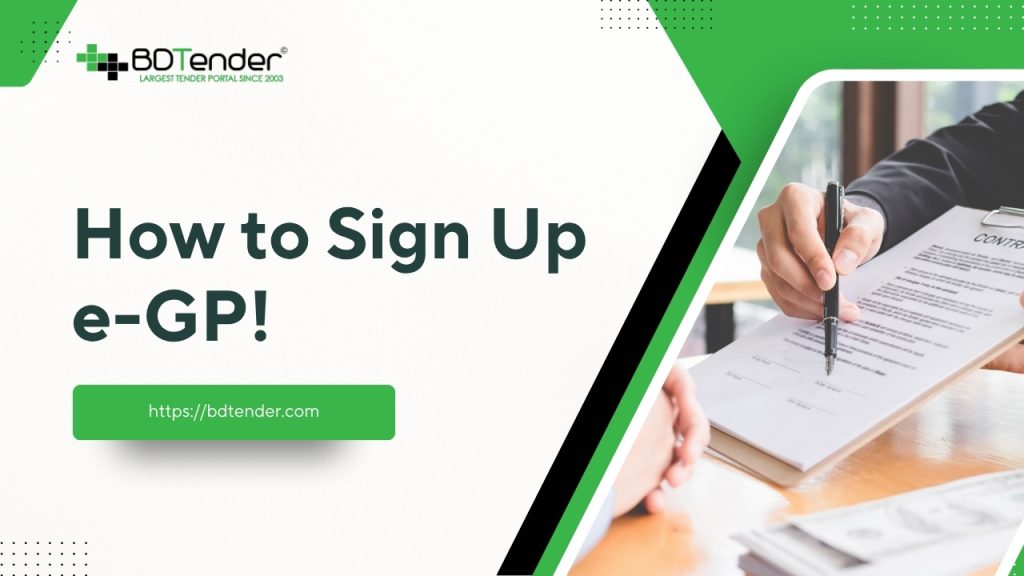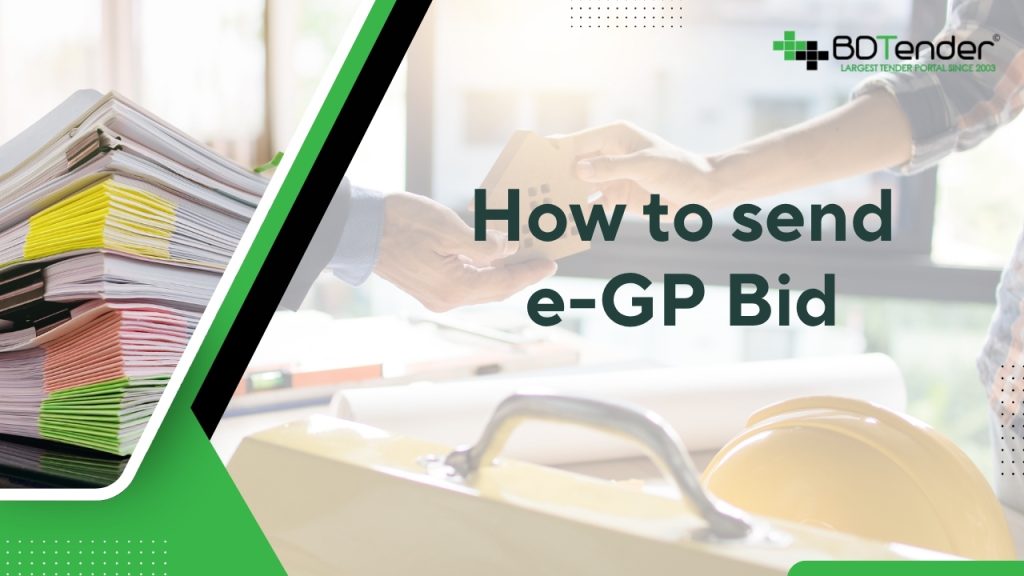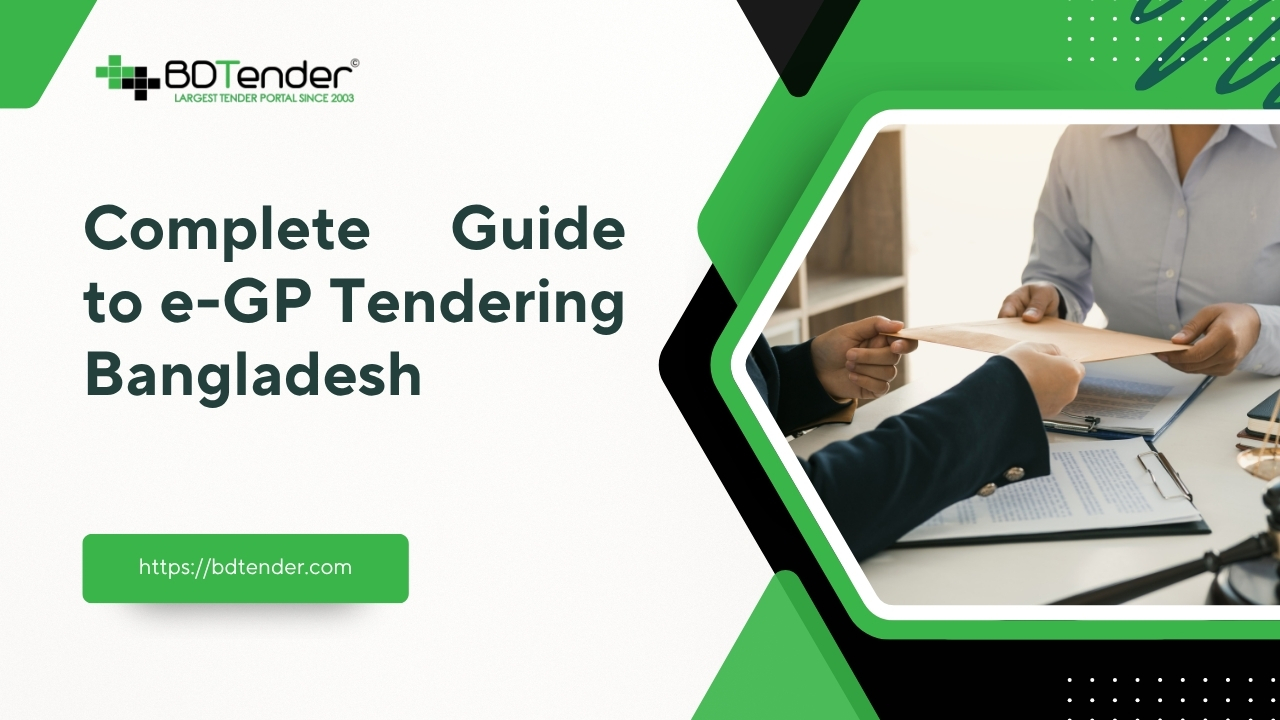What, Where, and Hows of e-GP
Your Complete Guide to e-GP Tendering in Bangladesh
For a long time, Bangladeshi contractors used old-fashioned ways to find out about government contracts. They would wait for news in the newspaper or from friends who worked in government agencies. The procedure was sluggish and frequently opaque, and many competent providers missed out because they didn’t know where to seek. One of them was a tiny construction company run by a young manager who had never tried to submit a government bid before. Like many others, they thought that only enormous companies with insider knowledge and years of links to the government could bid on contracts. The company’s view started to shift when they found the e-GP site, which stands for electronic Government Procurement. The manager was keen to know more. He went up to eprocure.gov.bd and was instantly stunned by how much information Cyberspace had to offer. But behind that initial intricacy was a mechanism that made it easier for everyone to see egp tender postings.
What is e-GP?
The Government of Bangladesh’s official online purchasing mechanism is the e-GP site. It puts all egp tender notifications in one place online, where procurement groups from different ministries, divisions, and local governments may post new egp contract possibilities. Through a safe, open, and easy-to-use system, registered bidders may see these egp tender postings, download the tender papers, place bids, and even get alerts when they win. No more running after newspapers or banging on government doors. Everything was now online.
The hardest part is finding the right tender
The system made things easier and gave people more access than ever , but it also made things worse. If you haven’t used the e-GP site or had training, it may be hard to use. The manager immediately saw that having all the egp tender announcements in one location was both a good and a bad thing. Every month, thousands of egp tender postings were released in a wide range of fields, from telecommunications and infrastructure to supply chain logistics and consulting. The issue wasn’t if there were egp tender possibilities, but how to find the ones that fit their company needs. This was the first big problem the company had to confront. They spent hours looking via the portal, but they still had trouble finding egp tender possibilities that were relevant to their field. Filtering by department or kind of tender only helped somewhat. A lot of the terminology was technical, and some of the criteria weren’t obvious. The manager realized that missing the correct egp tender because of a mistake or misunderstanding may mean losing a lot of revenue.
How BDTender.com Made It Simple
BDTender.com proved to be a significant breakthrough for them. It’s a third-party site that collects and organizes egp tender offers in a way that’s much easier to utilize. BDTender has personalized search filters, categories depending on industry, daily notifications, and even reminders for deadlines. The company felt like they had a personal assistant helping them navigate the egp tender jungle for the first time. They could use BDTender to choose their company specialization, such as IT supply, road building, or consulting, and then only get daily updates about egp tender announcements that were relevant to them. The software not only helped them save time, but it also helped them make egp tender bids that were more precise and responsive. They didn’t have to depend on chance or guesses anymore. The egp bidding process was starting to seem less like a complicated government procedure and more like a business plan that could be followed. In a country where public procurement makes up a large part of GDP, being able to regularly find and react to the proper egp contract might be the difference between stagnation and steady growth. For this tiny construction company, the difference began with finding the e-GP site and the clever navigation tools that BDTender offers.
Getting to Know the Basics of the Platform
Before you start the process of filing an egp tender, you need to know how the platform works. In a way, e-GP is like a huge online store only for government purchases. Every day, different government groups, called Procurement Entities or PEs, post their needs on this unified platform. These criteria are shown as egp tender possibilities for industries, including products, works, and consulting services. We aim to include everyone in the system. Contractors from all around Bangladesh may see and take part in egp tender announcements without having to attend to government offices in person. You need to know how tenders are grouped, however, if you want to be included. The Open Tendering Method (OTM) is the most frequent way to do this, and it works for both products and services. For specialized or urgent purchases, the Limited Tendering Method (LTM) is another common purchasing strategy. There are other direct procurement methods, requests for quotations (RFQ), and ways to choose a consultant, such as quality- and cost-based selection (QCBS). Every way to submit an egp tender has its own rules and procedures. Some egp tenders, for instance, can seek for employment experience in a certain field, while others might ask for certain financial records or technological skills. If you want to choose and react to the proper egp tender announcements, you need to know what these categories mean.

How to Sign Up for e-GP
The first thing you need to do to bid on an egp contract is to register. You can’t get egp contract materials, talk to procurement companies, or send in any proposals if you don’t register. At first, the registration procedure could seem overwhelming, but it’s really not that hard if you break it down. First, anyone who wants to bid must go to the official website eprocure.gov.bd and start the registration procedure. The system will ask for some basic information about the business, such as a valid trading license, a Tax Identification Number (TIN), and VAT registration. You also need to have an active bank account. Most importantly, the company needs to obtain a Digital Signature Certificate (DSC). This certificate represents your digital identification, and you need it to safely submit any egp tender. You just have to register on the site once, but you need to be very careful. If there is a mistake in your paperwork, it might take longer for you to get to egp tender chances. So, make sure that all of your company papers are up-to-date, scanned correctly, and easy to read.
My First Time registering
I took the initiative in registering our company on the e-GP site when the construction company I was working with decided to look into egp contract chances. The procedure seemed overwhelming at first. But being patient and following each step paid off. We went to the e-GP website and clicked on the Bidder Registration link. We entered our company information and submitted the necessary documents there. A scheduled bank made a payment for a treasury challan. After we completed the verification process, we received our bidder ID and login information. It felt as if we had stepped into an entirely new realm of business growth. From that day on, we could see hundreds of egp tender ads from different departments. The registration did more than simply let us bid on contracts. It opened the door to learning, working together, and making more money.
Getting Your Tender Documents ready
The next step is to get ready when you sign up. It’s not as easy as merely clicking a button to submit an egp tender. It needs well-organized paperwork that is particular to each egp tender. The most important papers are the firm profile, certifications of appropriate work experience, financial accounts that indicate yearly turnover, staff information, and a list of machinery or technical equipment. These papers don’t fit everyone. There are distinct criteria and eligibility standards for each egp tender. It is very important to read each egp tender notice attentively and write a response that is specific to that notification. Depending on the tender, you may need to provide other papers, including bank solvency certifications or line of credit confirmations. Providing a thorough and compliant bid package is crucial for evaluation.
Become familiar with the e-GP Portal
The layout of the e-GP site is organized. To get the most out of egp tender listings, you need to know how to use its main features. The main dashboard has important parts like “My Tenders,” “Inbox,” “Correspondence,” and “Submitted Tenders.” “My Tenders” shows you egp tender alerts that you are interested in or have saved. “Inbox” is where PEs will send you messages or updates on your involvement or ask you questions. “Correspondence” is a mechanism for the bidder and the procurement entity to talk to one another. “Submitted Tenders” keeps track of all the bids you’ve made in the past. Understanding these parts can make your job easier and help you meet deadlines and avoid misunderstandings during an EGP tender. The gateway is meant to manage a lot of communication and paperwork. Bidders who know how these things work do better and are more confident.
How to Read a Tender Notice
You shouldn’t just scan over an egp tender notification. There is useful information in every line of the paper. You need to read it all the way through to understand the scope, deliverables, qualification requirements, and assessment criteria. Learn the proposal’s due date, financial criteria, prior experience, and technical details. Some egp tender postings may include when the pre-bid meeting will be. Some people may need requests for clarification to be made within a certain amount of time. Understanding these minor details could make the difference between qualifying and not qualifying. Always save and read the portions of the egp tender document one at a time. Use the clarification window on the gateway to ask questions if anything isn’t clear. This demonstrates that you are interested and helps you avoid making mistakes.
Understanding the Qualification Criteria
Some people say that qualification is the most important portion of any egp tender. Most egp tender notifications will include what you need to do to be eligible, such as having worked on comparable projects in the last five years, having a certain yearly turnover, having a certain number of trained workers, and having access to the right tools. Some bids, notably in the healthcare or energy industries, need ISO certificates or legal authorization. Some may authorize joint ventures, or JVs, in which two or more companies work together to achieve the requirements. Joining a joint venture is particularly advantageous for small businesses that want to get expertise with egp tenders. If you carefully match your company’s capabilities to the qualifying requirements in an egp tender, you will save time and have a better chance of winning.
Subcontracting as a Way to Get In
Subcontracting is another method to become involved with egp bidding initiatives. If your company is young or doesn’t have the expertise needed to fulfill a certain egp tender requirement, it can be smart to become a subcontractor for a bigger winning bidder. This method enables you to get experience on the job, add to your portfolio, and make connections with larger companies in the field. A lot of well-known contractors today started out as subcontractors working on egp bidding contracts. Over time, this involvement helps build the confidence, financial profile, and credentials required to bid on future egp contract chances on your own. Businesses may set themselves up to win all the time by learning about the whole platform and its ecosystem, from signing up and filling out paperwork to qualifying and submitting. Not every egp tender is a bid. It is a door to organized development, stability, and long-term change.

How to send an e-GP Bid
It may be hard to submit an egp tender, especially if you haven’t done it before. But with practice and the correct knowledge, the process becomes easier and even normal. Every egp tender submission has to follow a certain pattern. Knowing this format well will help a bidder stay competitive and obey the rules. Preparing two types of documentation is usually needed for each egp tender: technical and financial. The technical proposal contains information about the bidder’s firm, their past work that is relevant, the credentials of their technical team, a list of the equipment they have, and a suggested way of doing the task. The pricing schedule and the BOQ (Bill of Quantities) are part of the financial documentation. All files must be in PDF format and have the right labels, as the e-GP system says they should. Each registered bidder has an e-GP dashboard that they use to submit their bids. Users may upload, organize, and preview their documents on the platform before they send them in. It’s very important to make sure that all the data are uploaded in the right order and match the system’s requirements, particularly when working with a complicated egp tender that has a lot of annexes. If anything is misplaced or left out, it may be automatically rejected.
Tender Security and Final Submission
The Electronic Tender Security is a must-have for any egp tender submission. This security is usually in the form of a bank guarantee or pay order and cannot be changed. The submission is not valid without it. The bidder may finish the submission after all the necessary papers have been submitted and the tender security is in place. After this stage, the system encrypts the bid, making it impossible to amend it until the tender is formally launched. Submitting an egp tender with all the right paperwork before the deadline is a big step toward being eligible for assessment.
After You submit
The platform starts updating the status in real time as soon as the egp tender is sent in. Bidders may see how their tender is doing by looking at its status, which might be “Submitted,” “Opened,” “Responsive,” or “Evaluated.” The procurement body then starts the technical and financial assessment process. If the egp tender passes the technical examination, the financial materials are accessed and looked over. The ultimate choice will rely on how well the prices compare and how well the terms and conditions are followed overall. A Notice of Award (NOA) is sent out after a successful egp tender, which formally confirms the bidder’s choice. Getting an NOA is a very important step in the egp bidding process and means that the contract execution phase has begun.
Finishing the Award Process
After getting the NOA, the chosen bidder must provide performance security, which is usually a larger sum than the tender security. This phase makes sure that the contractor is serious about following through on the contract. After that, the contract is signed. As per the initial requirements of the egp tender, all deliverables, project dates, and reporting duties are clearly spelled out. You must follow these rules; if you don’t, you might face fines or possibly be barred from future tenders.
The winning bidder must initiate the project and begin executing it.
The winning bidder must start gathering resources after signing the contract. This involves hiring people, getting supplies, and starting work on the timeline set forth in the egp tender application. The project’s development is monitored through regular updates, site inspections, and the filing of paperwork. If the bidder can handle this phase well, they will not only complete the present contract, but they will also improve their chances of winning future egp tenders. A well-run egp tender creates confidence with government agencies and helps you get higher scores on future tender reviews.
Training That Gets a Company Ready to Tender
Professional training may help companies that don’t know how to do the egp tender procedure or are having trouble succeeding. BDTender has designed a special training curriculum only for preparing and submitting egp tenders. This tool covers every step of the egp tender lifecycle, from registering and organizing documents to submitting them in real time.

Why BDTender Training Is Effective
Engineer Mizan leads BDTender’s training. Mizanur Rahman, a well-known trainer in the country, walks you through every stage of the egp tender process. Participants take part in mock submissions for OTM commodities, OTM works, and LTM formats. Each lesson covers essential documents, safeguarding your tender, evaluating bids, and maintaining compliance. Participants learn how to enhance their egp tender success rates via real-world examples, simulated assessments, and hands-on feedback. The training also stresses the need to avoid disqualification by carefully handling documents and meeting deadlines. Many companies who were bewildered by the egp tender procedure have greatly improved their bidding approach after taking part in BDTender’s training. They say they are more accurate when preparing proposals, understand assessment rationale better, and feel more confident when bidding on contracts. These companies have a clear edge in the egp tender market because they have learned how to find mistakes in tender papers, manage team procedures, and follow submission rules.
One Last Thing: Making e-GP a Business Asset
The egp tender platform in Bangladesh is more than just a digital tool; it’s a chance for companies to grow, make their operations more official, and compete for high-value government contracts. By using both the search tools on BDTender.com and the professional advice on egp-training businesses can set themselves up for success in the public procurement market. Whether you’re new to tendering or want to get better results, regularly following egp tender protocols can help you get more attention, score higher, and do better business. The egp tender procedure makes sure that everyone has an equal chance by being open and honest. It offers more than just participation; it can transform individuals who are prepared and qualified.

